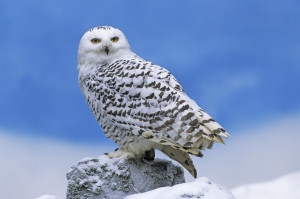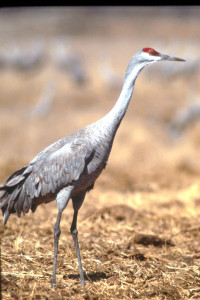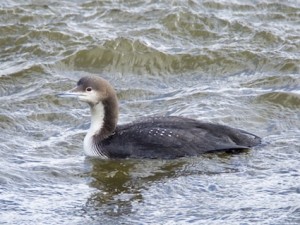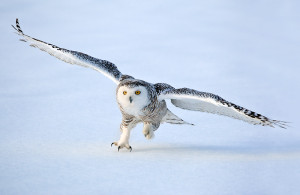Three Firsts on the First
The holiday season brings, among other things, loved ones from near and far. Yet by the first of the year, most have left and life returns to its relative normalcy. This New Year’s Day, however, was different indeed. On January 1, 2014, there were representatives from the Heartlands, the West, and even the Arctic. Friends never met, but only admired through the reports of friends on a listserv.
Inland, the 22˚ morning skies were crisp and clear, and free from wind. The cornfields lining the road were easy to see across, but also completely devoid of life. I’d followed the rumors and was beginning to lose hope. As my rusty maroon van trundled down a side road, I had just decided it was about time to turn around when a white car parked along the side of the road got my curiosity going. There were only fields and an occasional barn along here; why would anyone stop? But when I drove past, there was only an older couple inside; no binoculars, field guides, or scopes visible. That’s enough; drive a bit farther and turn around.
I did drive farther down. I didn’t turn around.
Because in the front yard of one of the few houses on that road stood my visitor from the Midwest. Tall, gray, slim, undeniably handsome. A Sandhill crane. He (or she) stood not 30 feet from me, looking completely at home, despite being miles from where he should be. The Sandhill can be found from Canada through to places like Texas depending on the time of year, but always well west of our coast. Yet here he was, placidly poking around in the lawn after roots or perhaps a grub. We looked at each other for a while, and I thanked him for offering me such a perfect view while still ensconced in the warmth of my car.
There was something about seeing this animal, so tall, so regal, and so completely out of place, that struck me. I would later reread what Aldo Leopold so eloquently said about the crane:
“Our ability to perceive quality in nature begins, as in art, with the pretty. It expands through successive stages of the beautiful to values as yet uncaptured by language. The quality of cranes lies, I think, in this higher gamut, as yet beyond the reach of words.
This much, though, can be said: our appreciation of the crane grows with the slow unraveling of earthly history. His tribe, we now know, stems out of the remote Eocene. The other members of the fauna in which he originated are long since entombed within the hills… He is the symbol of our untamable past, of that incredible sweep of millennia which underlies and conditions the daily affairs of birds and men.”
– Aldo Leopold, A Sand County Almanac
After a long visit, I decided to test my luck and quest after other rumored visitors from far away.
I started scanning the area as soon as I reached Charlestown. A pond behind the volunteer firehouse was skimmed with ice, well on its way to a much thicker frozen state. While the little pond is often a good place for duck sightings, frozen water means no food, which in turn usually means no ducks. Nothing but sunshine.
Heading down Charlestown Beach Road is normally a solitary drive in the winter, but a car appeared behind me, then one behind that. Had they heard something about my quarry? Surely birders would be communicating the latest sightings by cell phone. More traffic appeared in each direction, which struck me as odd and exciting at the same time. Were there really this many people interested in New Year’s birding?
Well, no. At Charlestown beach, I was greeted with the odd sight of someone directing traffic into a parking lot. At the same time, I caught sight of four people wrapped in towels scaling the dunes toward the ocean. What I had been witnessing was not an irruption of birders, but a gathering of crazies and spectators for a New Year’s Day penguin plunge. Another day, a sight like that might have made me follow the crowds, but not today. I was looking for visitors of a different sort, and continued driving.
The road to the Breachway was lined with pretty little cottages, each sporting one of two large signs: NO TRESSPASSING, or FOR RENT. The sight brought me back to the sympathetic stories about property owners losing their homes during Superstorm Sandy, and I thought for a moment about how my tax dollars would pay for repairs to places I could never afford. Better to let that go, rather than allow it to ruin the adventure, I supposed. I rolled past the booth that houses the parking attendant in summer, now thankfully empty.The dirt parking lot of the Charlestown Breachway held a few cars, which it seems to no matter what the weather.
Knowing there would be a bracing wind, I climbed out and began to put on more layers. As I did, I could see birders to the left and right with cameras and scopes pointed across the breachway. All things being equal, I ventured to the right, where the water forms a kind of inlet. There swam the second misplaced visitor of the day: the Pacific loon.
Why in the world it was across the country from its normal wintering grounds was impossible to tell, but here it was, solitary but not seeming to have any difficulty in its new environment. If it had brought a few friends, perhaps it would have engaged in the type of behavior described in the Cornell Lab of Ornithology’s website:
“Pacific and Arctic loons in the waters off Japan in late winter forage cooperatively, swimming under and around schools of sand lance (a small fish) and concentrating them into an area about one meter in diameter. Japanese fishermen exploited this habit by fishing for sea bream that gathered to feed on the sand lance. With such assistance from the loons, the fishermen could earn a year’s livelihood in February and March alone; as a result, the loons were worshiped as messengers from heaven. Now, this practice has ceased because of unexplained declines in loon populations, collapse of sea bream populations, and adoption of other fishing methods.”
– Allaboutbirds.org
Eventually, the larger flock of birders assembled nearer the mouth of the breachway became an irresistible temptation. No one turned as I approached. Each was fixated on something on the far side of the Breachway. Before lifting the binoculars to my eyes, I could make it out: amid the tans, grays, and browns of the winter dune was a stark black and white shape. Bubo scandiacus – the snowy owl.
It may be fair to say that this year’s irruption has been to birders what the arrival of Taylor Swift to her new digs in Watch Hill has been to teenagers. The internet has been buzzing with reports, and photos of it have warmed the hearts of many a winter birder. Unlike most owls, the snowy is a diurnal animal, an adaptation to the months-long daylight hours of its home territory hundreds of miles north of here. This, coupled with its habit of perching in open areas, has been a boon to fans of owls, since it makes viewing unusually simple.
Birds of America, a 1917 guide, describes the habits of the snowy this way:
“(The diurnal habit of the owl) has been discovered too late by many a Crow engaged with his brethren in the pleasing diversion of mobbing the big white specter sitting on a limb motionless, and presumably blind, because obviously an Owl. For, let one of the black tormentors come near enough and the ghost suddenly launches out on strong, silent wings, the great talons strike and close, and there is a Crow who would have been wiser but for the circumstance that he is very dead.”
– George GladdenI spent hours watching the snowy, often sharing my binoculars with dozens of people who had come to the area either by coincidence or design. Each time I passed them the binoculars, the story was the same: “Oh my GOD! He’s MAGNIFICENT!” Yes, yes he is.
Eventually the cold and wind drove me back to the van. Today was the first day of a new year, and it had begun with not one, not two, but three never before seen creatures for my bird list. Whatever other visitors the year brings, those three firsts on the first will be enough to keep me warm for a long time.
Note: Facebook has a new page called Project SNOWstorm with information about the snowy, as well as about the group’s goal of extending research about these animals while they are local. Also, the newly formed Rhode Island Birders has a great FB page for the latest sightings of all types of birds.











Nice read Hugh, i love you’re blog.
Thanks, Paul! I have a lot of fun doing it!